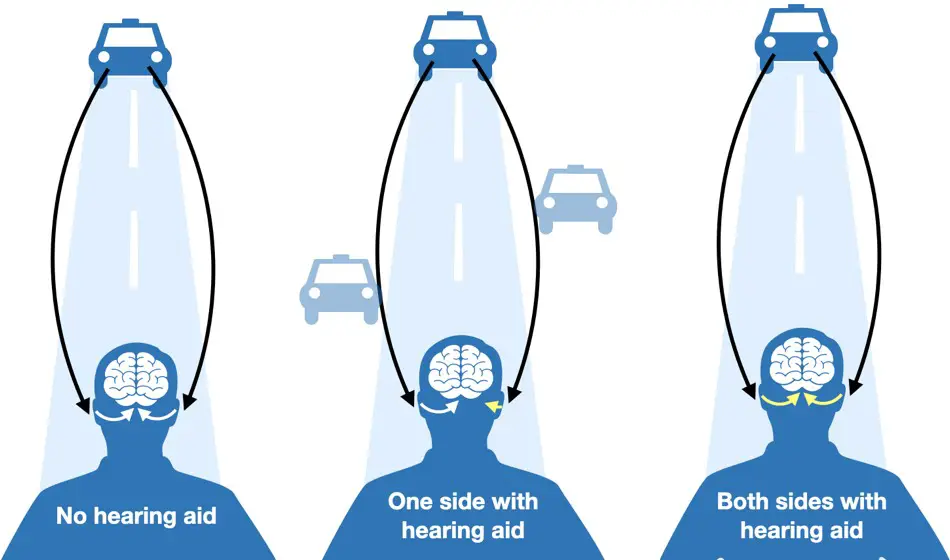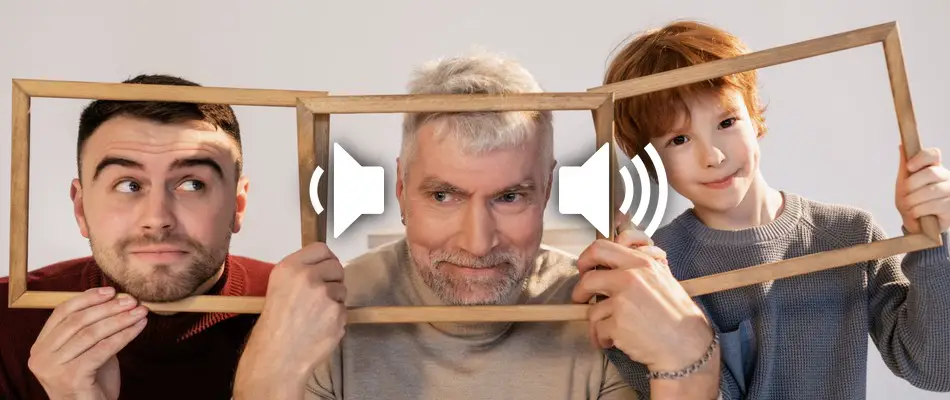In most cases, hearing loss is present in both ears. But sometimes people think about just getting one hearing aid instead of two. Despite the savings, you learn in this article why this might not be the best idea.
Wearing just one hearing aid although you actually need two might…
- Impair your ability to locate sounds in your environment
- Impair your ability to cut through the noise during a conversation
- It could give you less satisfaction wearing the hearing aid
- Provide you with less amplification
- Lead to auditory deprivation
Each of the bullet points listed will be explained in more depth in this article. In most cases, you do not hear those drawbacks directly when your hearing care professional gives you a few audio examples in the shop. In most cases, the drawbacks of wearing just one hearing aid instead of two show up sporadically in different situations during your daily activities.
Research also heavily backs the recommendation two hearing aids. In short the ease of listening, word recognition, in combination with attentional effort tasks for speech improve when both ears are stimulated in the same way. But let us dive a little deeper into the topic to give you a better explanation.
Why the Ability to Locate Sounds In Your Environment Might Get Worse With One Hearing Aid Instead of Two
In order to be able to know where a sound is coming from your brain uses the difference in time when a sound was heard in each ear and how loud it was. With modern hearing aids you oftentimes have a processing delay between 5-6ms until the hearing aid processed the sound and you can hear it.
Let us assume you wear a hearing aid just in the right ear. And suddenly a sound comes of signal horn in traffic and it comes from the street in front of you. Without hearing aids the sound is made by the horn and passes the air and and goes into the ear canals. Your ear drums vibrate at the same time and you locate the sound directly in front of you.
In the second scenario, you wear just one hearing aid on the right side. Again the horn makes a sound in front of you the sound travels through the air reaches the ear canal in your left ear and the microphone on the right ear. While the sound just goes in your left ear and reaches your eardrum the hearing aid on the right side takes 5 ms and then will stimulate your eardrum.

The result is you have a delay in regards to when the sound is received and how loud it was. Although 5-6ms does not sound as much this is enough to make it harder for you to tell where the sound actually came from. This example simplifies the process a bit because oftentimes the signal processing time for higher and lower-pitched sounds can vary too in one hearing aid. But this would blow the article up too much here.
The image above illustrates the confusion that might happen when the sound of the car is heard louder in one ear compared to the other as well as sooner in one ear and later in the other. This is just irritating. Usually, when a sound comes from the side of your ears one ear hears the sound a little earlier compared to another.
To be exact 0.2 to 0.8 milliseconds is the difference between them when it comes from the side without hearing aids. When both ears hear the sound simultaneously it must come from the front or from the back. With one hearing aid instead of two you will mix up this sensation.
Why Using One Hearing Aid Might Impair Your Ability to Cut Through the Noise During a Conversation
Using two hearing aids instead of one can give you an advantage especially in a noisy environment. Hearing aids have features to amplify sounds a little more in a certain direction in front of you. Let us assume you are sitting with a friend in a full restaurant. There is noise everywhere.
When both hearing aids are set to amplify sounds directly in front of you a little more while simultaneously reducing the volume a little for everything else in the room might give you the edge to follow the discussion more easily over a longer period of time.
Hearing loss may increase listening-related effort and fatigue due to the increased mental exertion required to attend to and understand, an auditory message. With one hearing aid instead of two this listening effort can be reduced especially because the sounds you want to hear get perceived a little louder with two hearing aids instead of one. You will find more on this in the next paragraph.
Increasing Amplification by Using Two Instead of One Hearing Aid
With hearing loss you need a certain amplification to hear and understand better. The amplification is a little lower when you just use one hearing aid. The concept behind this is called binaural summation effect.
In short, the listener perceives increased sound intensity when both ears are presented with a similar signal compared to that achieved by either ear alone. But it is not only about the increased perceptual loudness. Wearers of two hearing aids benefit from increased sensitivity to differences in intensity and frequency improving speech understanding in both quiet and in noise.
Are Wearers of One Hearing Aid Less Satisfied With the Fitting of the Hearing Aids?
In 2019 an interesting study was published by Amir Zulkefli and Wan Ahmad Wan Aslynn that looked at the satisfaction levels of wearers of one or two hearing aids. Their study has the title: SATISFACTION WITH AMPLIFICATION IN DAILY LIFE (SADL) IN MONAURAL AND BINAURAL HEARING AID USERS.
In the study different aspects were looked at like service and costs and appearance of the wearers of one or two hearing aids.
In this study, the results showed binaural hearing aid users were more satisfied in positive effect subscale, service and cost subscale as well as global score. Thus, it reflects that binaural hearing aid fitting gave more benefits instead of monaural.
But surprisingly, there are also studies that show the opposite. This is probably because monaural users considered that only one hearing aid may have already met their needs. This is also in agreement with other studies that found one hearing aid showed better speech recognition in a noisy background and reported less discomfort to loud sounds compared to using two hearing aids.
Auditory Deprivation
Using just one hearing aid instead of two means your brain will get less information. This comes from less stimulation of the ear and the hearing nerve. When the hearing nerves and areas within the brain are deprived of sound, they tend to atrophy or weaken over time. Lack of stimulation over a long time makes the process of wearing a hearing aid more difficult. It is referred to as auditory deprivation, first reported in 1984 by Silman et al. in 1992.

As you can see using two hearing aids instead of one gives you a lot more benefits. In the picture above you can see a typical situation where using one hearing aid would be very counter productive. Of course you could try your best to always position yourself in way so you can hear better with the ear fitted with the hearing aid. But of course you can not alway do it and in some cases you will miss key elements of a conversation you just can not get back to.
I wish you a great day.
